COIT20246 Assignment: Computing Architecture and Network Protocols
VerifiedAdded on 2020/03/28
|21
|4643
|34
Homework Assignment
AI Summary
This assignment for COIT20246 focuses on the historical development of computing and related technologies. It comprises ten tasks, each requiring a summary of a resource related to a specific week's topic. Week 1 examines Alan Turing's contributions to computer architecture and artificial intelligence. Week 2 explores Linus Torvalds' development of the Linux operating system. Week 3 delves into the origins of the internet, highlighting Tim Berners-Lee's role in the creation of the World Wide Web. Week 4 investigates the Fiber Distributed Data Interface (FDDI) as an example of a Layer 2 data link protocol. Week 5 discusses the actions of the hacker Adrian Lamo. The assignment requires students to find and summarize resources, demonstrating an understanding of the evolution of computing and the individuals and technologies that have shaped it.
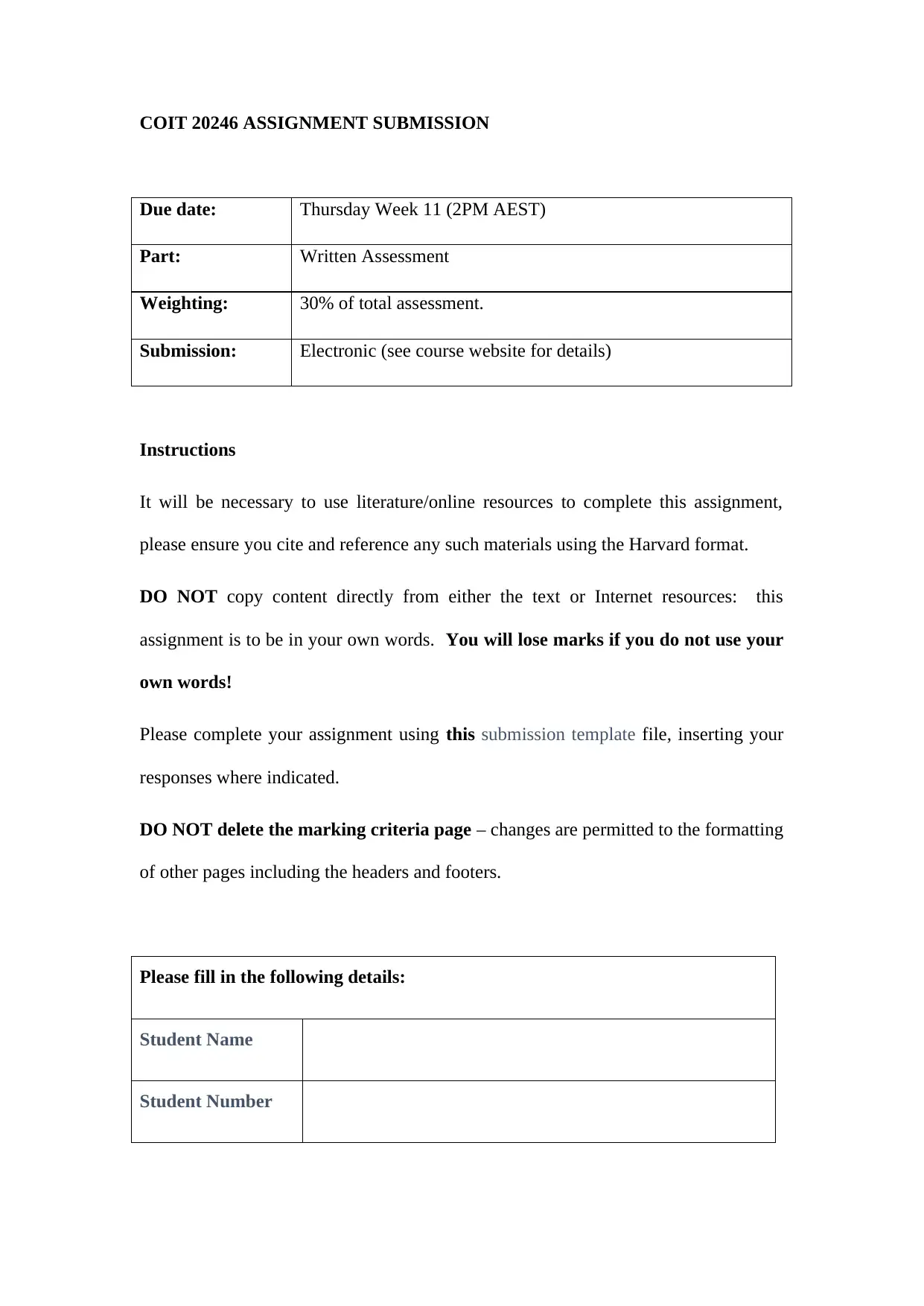
COIT 20246 ASSIGNMENT SUBMISSION
Due date: Thursday Week 11 (2PM AEST)
Part: Written Assessment
Weighting: 30% of total assessment.
Submission: Electronic (see course website for details)
Instructions
It will be necessary to use literature/online resources to complete this assignment,
please ensure you cite and reference any such materials using the Harvard format.
DO NOT copy content directly from either the text or Internet resources: this
assignment is to be in your own words. You will lose marks if you do not use your
own words!
Please complete your assignment using this submission template file, inserting your
responses where indicated.
DO NOT delete the marking criteria page – changes are permitted to the formatting
of other pages including the headers and footers.
Please fill in the following details:
Student Name
Student Number
Due date: Thursday Week 11 (2PM AEST)
Part: Written Assessment
Weighting: 30% of total assessment.
Submission: Electronic (see course website for details)
Instructions
It will be necessary to use literature/online resources to complete this assignment,
please ensure you cite and reference any such materials using the Harvard format.
DO NOT copy content directly from either the text or Internet resources: this
assignment is to be in your own words. You will lose marks if you do not use your
own words!
Please complete your assignment using this submission template file, inserting your
responses where indicated.
DO NOT delete the marking criteria page – changes are permitted to the formatting
of other pages including the headers and footers.
Please fill in the following details:
Student Name
Student Number
Paraphrase This Document
Need a fresh take? Get an instant paraphrase of this document with our AI Paraphraser
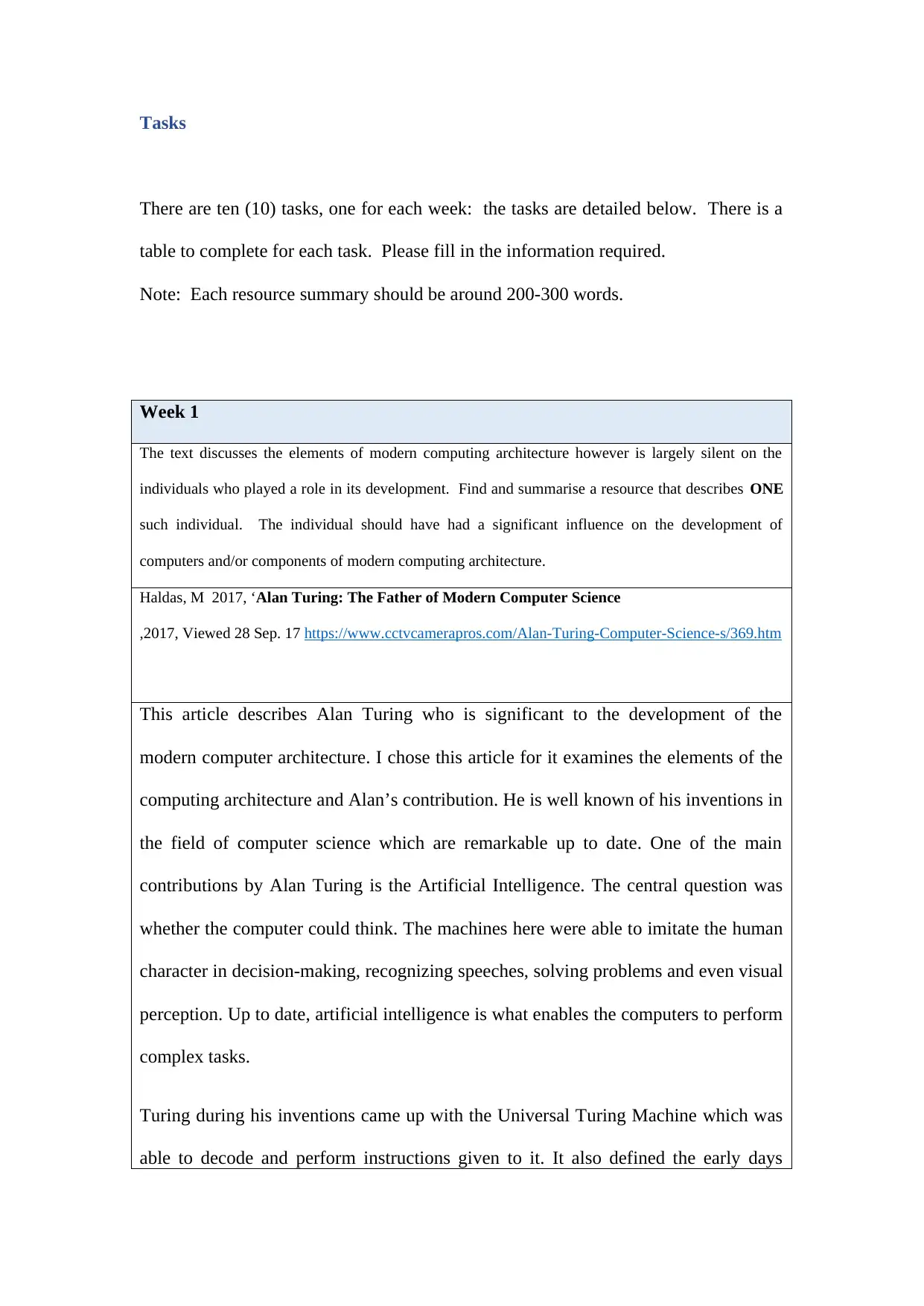
Tasks
There are ten (10) tasks, one for each week: the tasks are detailed below. There is a
table to complete for each task. Please fill in the information required.
Note: Each resource summary should be around 200-300 words.
Week 1
The text discusses the elements of modern computing architecture however is largely silent on the
individuals who played a role in its development. Find and summarise a resource that describes ONE
such individual. The individual should have had a significant influence on the development of
computers and/or components of modern computing architecture.
Haldas, M 2017, ‘Alan Turing: The Father of Modern Computer Science
,2017, Viewed 28 Sep. 17 https://www.cctvcamerapros.com/Alan-Turing-Computer-Science-s/369.htm
This article describes Alan Turing who is significant to the development of the
modern computer architecture. I chose this article for it examines the elements of the
computing architecture and Alan’s contribution. He is well known of his inventions in
the field of computer science which are remarkable up to date. One of the main
contributions by Alan Turing is the Artificial Intelligence. The central question was
whether the computer could think. The machines here were able to imitate the human
character in decision-making, recognizing speeches, solving problems and even visual
perception. Up to date, artificial intelligence is what enables the computers to perform
complex tasks.
Turing during his inventions came up with the Universal Turing Machine which was
able to decode and perform instructions given to it. It also defined the early days
There are ten (10) tasks, one for each week: the tasks are detailed below. There is a
table to complete for each task. Please fill in the information required.
Note: Each resource summary should be around 200-300 words.
Week 1
The text discusses the elements of modern computing architecture however is largely silent on the
individuals who played a role in its development. Find and summarise a resource that describes ONE
such individual. The individual should have had a significant influence on the development of
computers and/or components of modern computing architecture.
Haldas, M 2017, ‘Alan Turing: The Father of Modern Computer Science
,2017, Viewed 28 Sep. 17 https://www.cctvcamerapros.com/Alan-Turing-Computer-Science-s/369.htm
This article describes Alan Turing who is significant to the development of the
modern computer architecture. I chose this article for it examines the elements of the
computing architecture and Alan’s contribution. He is well known of his inventions in
the field of computer science which are remarkable up to date. One of the main
contributions by Alan Turing is the Artificial Intelligence. The central question was
whether the computer could think. The machines here were able to imitate the human
character in decision-making, recognizing speeches, solving problems and even visual
perception. Up to date, artificial intelligence is what enables the computers to perform
complex tasks.
Turing during his inventions came up with the Universal Turing Machine which was
able to decode and perform instructions given to it. It also defined the early days
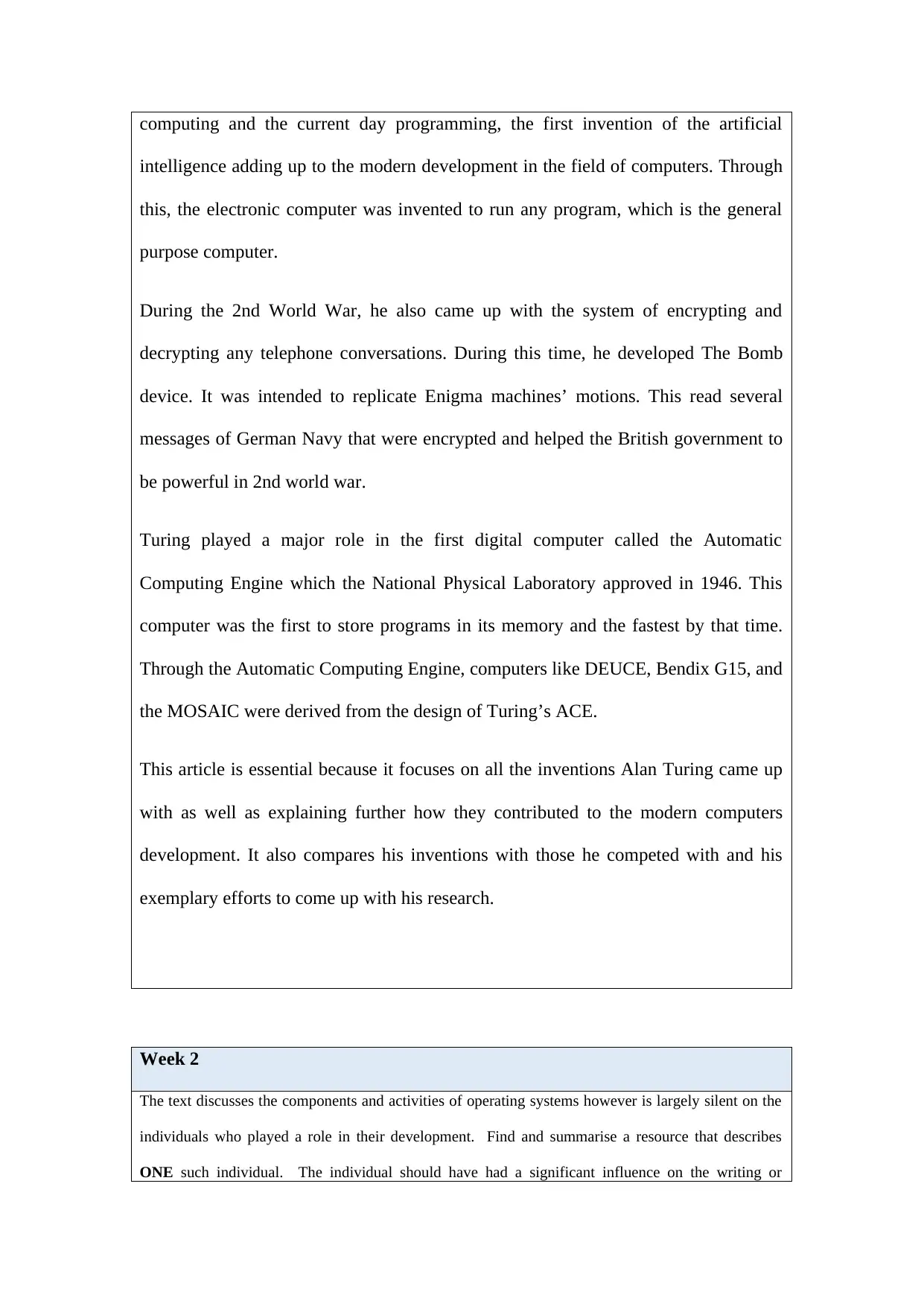
computing and the current day programming, the first invention of the artificial
intelligence adding up to the modern development in the field of computers. Through
this, the electronic computer was invented to run any program, which is the general
purpose computer.
During the 2nd World War, he also came up with the system of encrypting and
decrypting any telephone conversations. During this time, he developed The Bomb
device. It was intended to replicate Enigma machines’ motions. This read several
messages of German Navy that were encrypted and helped the British government to
be powerful in 2nd world war.
Turing played a major role in the first digital computer called the Automatic
Computing Engine which the National Physical Laboratory approved in 1946. This
computer was the first to store programs in its memory and the fastest by that time.
Through the Automatic Computing Engine, computers like DEUCE, Bendix G15, and
the MOSAIC were derived from the design of Turing’s ACE.
This article is essential because it focuses on all the inventions Alan Turing came up
with as well as explaining further how they contributed to the modern computers
development. It also compares his inventions with those he competed with and his
exemplary efforts to come up with his research.
Week 2
The text discusses the components and activities of operating systems however is largely silent on the
individuals who played a role in their development. Find and summarise a resource that describes
ONE such individual. The individual should have had a significant influence on the writing or
intelligence adding up to the modern development in the field of computers. Through
this, the electronic computer was invented to run any program, which is the general
purpose computer.
During the 2nd World War, he also came up with the system of encrypting and
decrypting any telephone conversations. During this time, he developed The Bomb
device. It was intended to replicate Enigma machines’ motions. This read several
messages of German Navy that were encrypted and helped the British government to
be powerful in 2nd world war.
Turing played a major role in the first digital computer called the Automatic
Computing Engine which the National Physical Laboratory approved in 1946. This
computer was the first to store programs in its memory and the fastest by that time.
Through the Automatic Computing Engine, computers like DEUCE, Bendix G15, and
the MOSAIC were derived from the design of Turing’s ACE.
This article is essential because it focuses on all the inventions Alan Turing came up
with as well as explaining further how they contributed to the modern computers
development. It also compares his inventions with those he competed with and his
exemplary efforts to come up with his research.
Week 2
The text discusses the components and activities of operating systems however is largely silent on the
individuals who played a role in their development. Find and summarise a resource that describes
ONE such individual. The individual should have had a significant influence on the writing or
⊘ This is a preview!⊘
Do you want full access?
Subscribe today to unlock all pages.

Trusted by 1+ million students worldwide
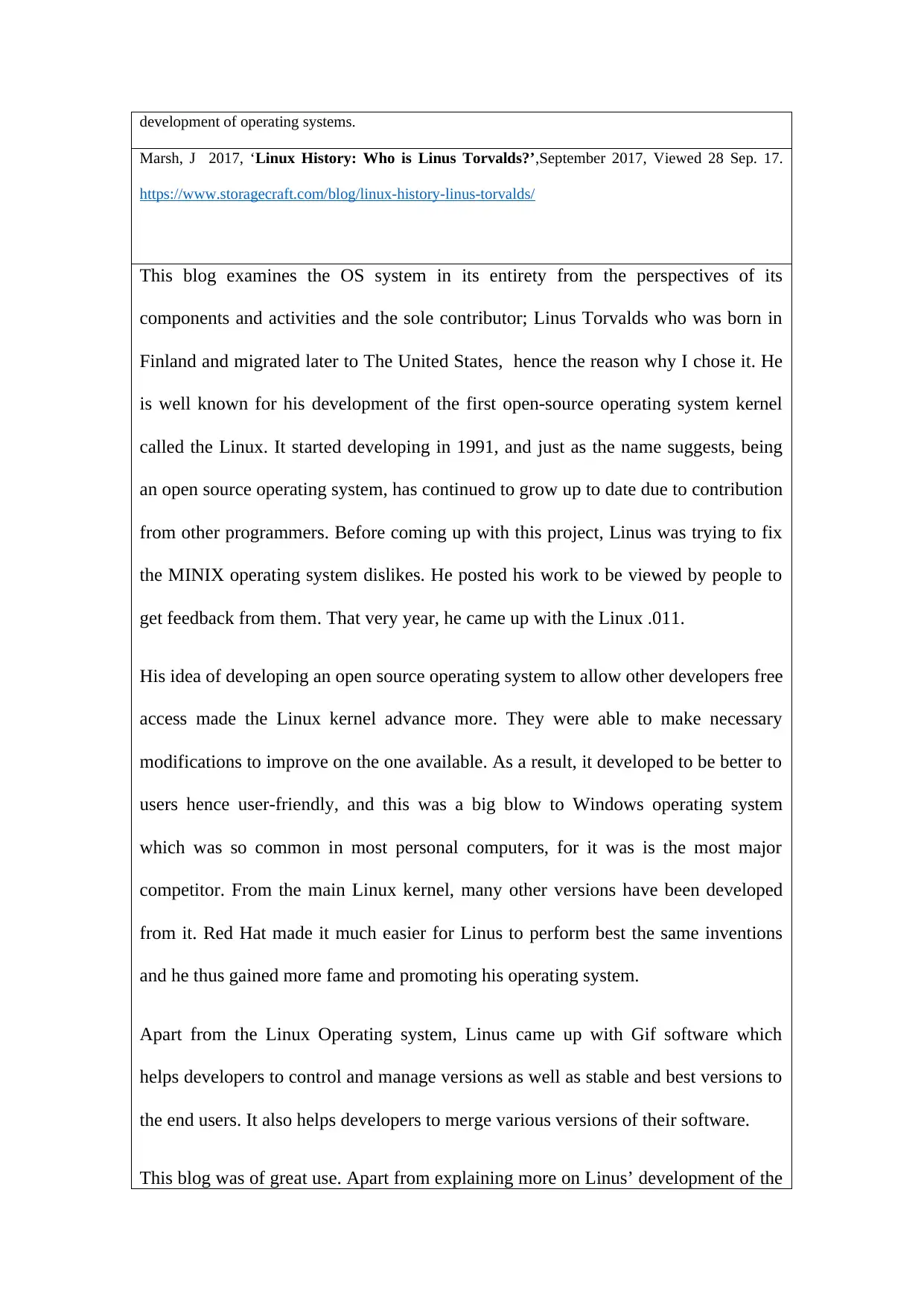
development of operating systems.
Marsh, J 2017, ‘Linux History: Who is Linus Torvalds?’,September 2017, Viewed 28 Sep. 17.
https://www.storagecraft.com/blog/linux-history-linus-torvalds/
This blog examines the OS system in its entirety from the perspectives of its
components and activities and the sole contributor; Linus Torvalds who was born in
Finland and migrated later to The United States, hence the reason why I chose it. He
is well known for his development of the first open-source operating system kernel
called the Linux. It started developing in 1991, and just as the name suggests, being
an open source operating system, has continued to grow up to date due to contribution
from other programmers. Before coming up with this project, Linus was trying to fix
the MINIX operating system dislikes. He posted his work to be viewed by people to
get feedback from them. That very year, he came up with the Linux .011.
His idea of developing an open source operating system to allow other developers free
access made the Linux kernel advance more. They were able to make necessary
modifications to improve on the one available. As a result, it developed to be better to
users hence user-friendly, and this was a big blow to Windows operating system
which was so common in most personal computers, for it was is the most major
competitor. From the main Linux kernel, many other versions have been developed
from it. Red Hat made it much easier for Linus to perform best the same inventions
and he thus gained more fame and promoting his operating system.
Apart from the Linux Operating system, Linus came up with Gif software which
helps developers to control and manage versions as well as stable and best versions to
the end users. It also helps developers to merge various versions of their software.
This blog was of great use. Apart from explaining more on Linus’ development of the
Marsh, J 2017, ‘Linux History: Who is Linus Torvalds?’,September 2017, Viewed 28 Sep. 17.
https://www.storagecraft.com/blog/linux-history-linus-torvalds/
This blog examines the OS system in its entirety from the perspectives of its
components and activities and the sole contributor; Linus Torvalds who was born in
Finland and migrated later to The United States, hence the reason why I chose it. He
is well known for his development of the first open-source operating system kernel
called the Linux. It started developing in 1991, and just as the name suggests, being
an open source operating system, has continued to grow up to date due to contribution
from other programmers. Before coming up with this project, Linus was trying to fix
the MINIX operating system dislikes. He posted his work to be viewed by people to
get feedback from them. That very year, he came up with the Linux .011.
His idea of developing an open source operating system to allow other developers free
access made the Linux kernel advance more. They were able to make necessary
modifications to improve on the one available. As a result, it developed to be better to
users hence user-friendly, and this was a big blow to Windows operating system
which was so common in most personal computers, for it was is the most major
competitor. From the main Linux kernel, many other versions have been developed
from it. Red Hat made it much easier for Linus to perform best the same inventions
and he thus gained more fame and promoting his operating system.
Apart from the Linux Operating system, Linus came up with Gif software which
helps developers to control and manage versions as well as stable and best versions to
the end users. It also helps developers to merge various versions of their software.
This blog was of great use. Apart from explaining more on Linus’ development of the
Paraphrase This Document
Need a fresh take? Get an instant paraphrase of this document with our AI Paraphraser

Linux Operating System, it also identified the other software called Gif which is
essential in the field of computers more so to those developing programs.
essential in the field of computers more so to those developing programs.
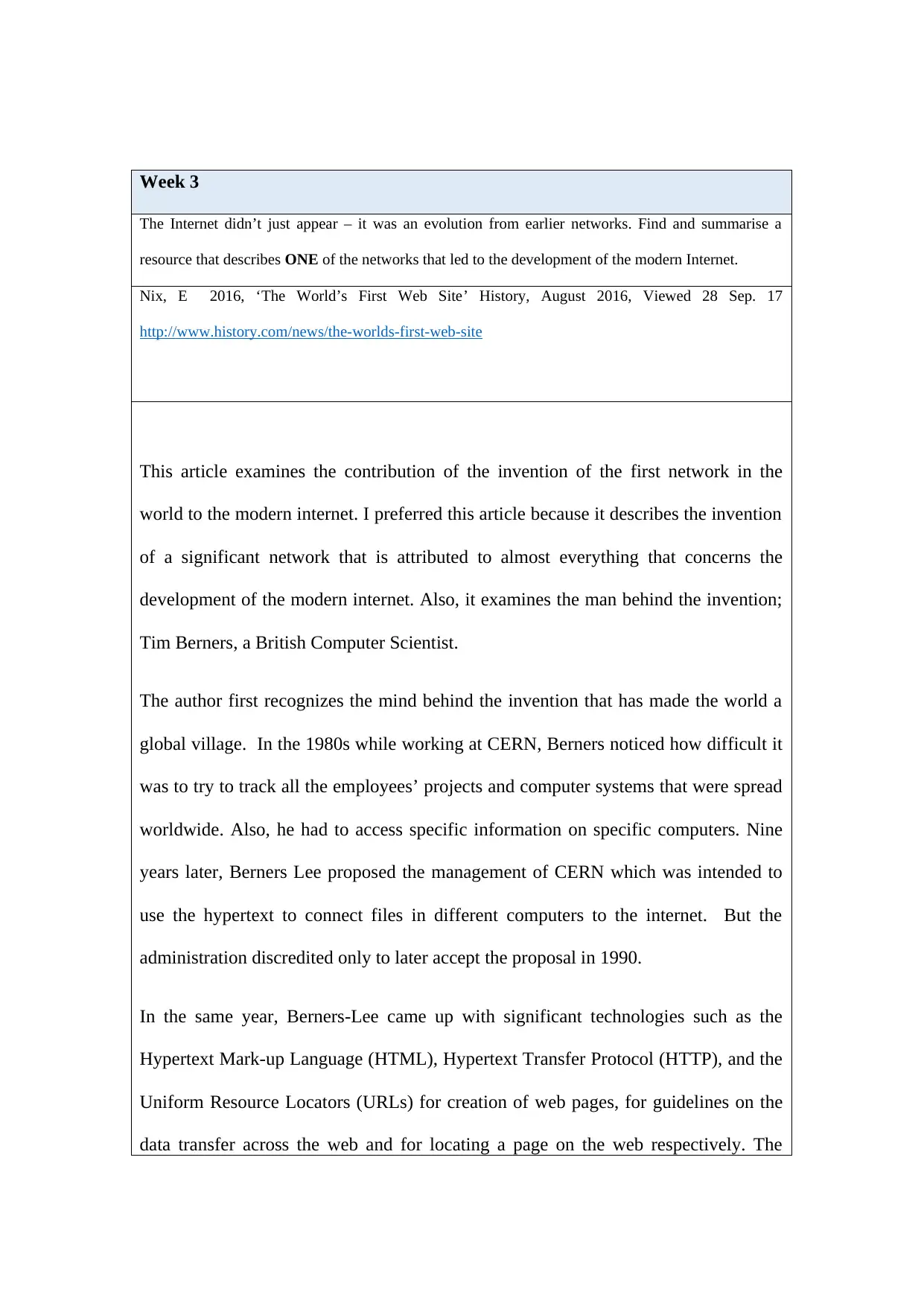
Week 3
The Internet didn’t just appear – it was an evolution from earlier networks. Find and summarise a
resource that describes ONE of the networks that led to the development of the modern Internet.
Nix, E 2016, ‘The World’s First Web Site’ History, August 2016, Viewed 28 Sep. 17
http://www.history.com/news/the-worlds-first-web-site
This article examines the contribution of the invention of the first network in the
world to the modern internet. I preferred this article because it describes the invention
of a significant network that is attributed to almost everything that concerns the
development of the modern internet. Also, it examines the man behind the invention;
Tim Berners, a British Computer Scientist.
The author first recognizes the mind behind the invention that has made the world a
global village. In the 1980s while working at CERN, Berners noticed how difficult it
was to try to track all the employees’ projects and computer systems that were spread
worldwide. Also, he had to access specific information on specific computers. Nine
years later, Berners Lee proposed the management of CERN which was intended to
use the hypertext to connect files in different computers to the internet. But the
administration discredited only to later accept the proposal in 1990.
In the same year, Berners-Lee came up with significant technologies such as the
Hypertext Mark-up Language (HTML), Hypertext Transfer Protocol (HTTP), and the
Uniform Resource Locators (URLs) for creation of web pages, for guidelines on the
data transfer across the web and for locating a page on the web respectively. The
The Internet didn’t just appear – it was an evolution from earlier networks. Find and summarise a
resource that describes ONE of the networks that led to the development of the modern Internet.
Nix, E 2016, ‘The World’s First Web Site’ History, August 2016, Viewed 28 Sep. 17
http://www.history.com/news/the-worlds-first-web-site
This article examines the contribution of the invention of the first network in the
world to the modern internet. I preferred this article because it describes the invention
of a significant network that is attributed to almost everything that concerns the
development of the modern internet. Also, it examines the man behind the invention;
Tim Berners, a British Computer Scientist.
The author first recognizes the mind behind the invention that has made the world a
global village. In the 1980s while working at CERN, Berners noticed how difficult it
was to try to track all the employees’ projects and computer systems that were spread
worldwide. Also, he had to access specific information on specific computers. Nine
years later, Berners Lee proposed the management of CERN which was intended to
use the hypertext to connect files in different computers to the internet. But the
administration discredited only to later accept the proposal in 1990.
In the same year, Berners-Lee came up with significant technologies such as the
Hypertext Mark-up Language (HTML), Hypertext Transfer Protocol (HTTP), and the
Uniform Resource Locators (URLs) for creation of web pages, for guidelines on the
data transfer across the web and for locating a page on the web respectively. The
⊘ This is a preview!⊘
Do you want full access?
Subscribe today to unlock all pages.

Trusted by 1+ million students worldwide
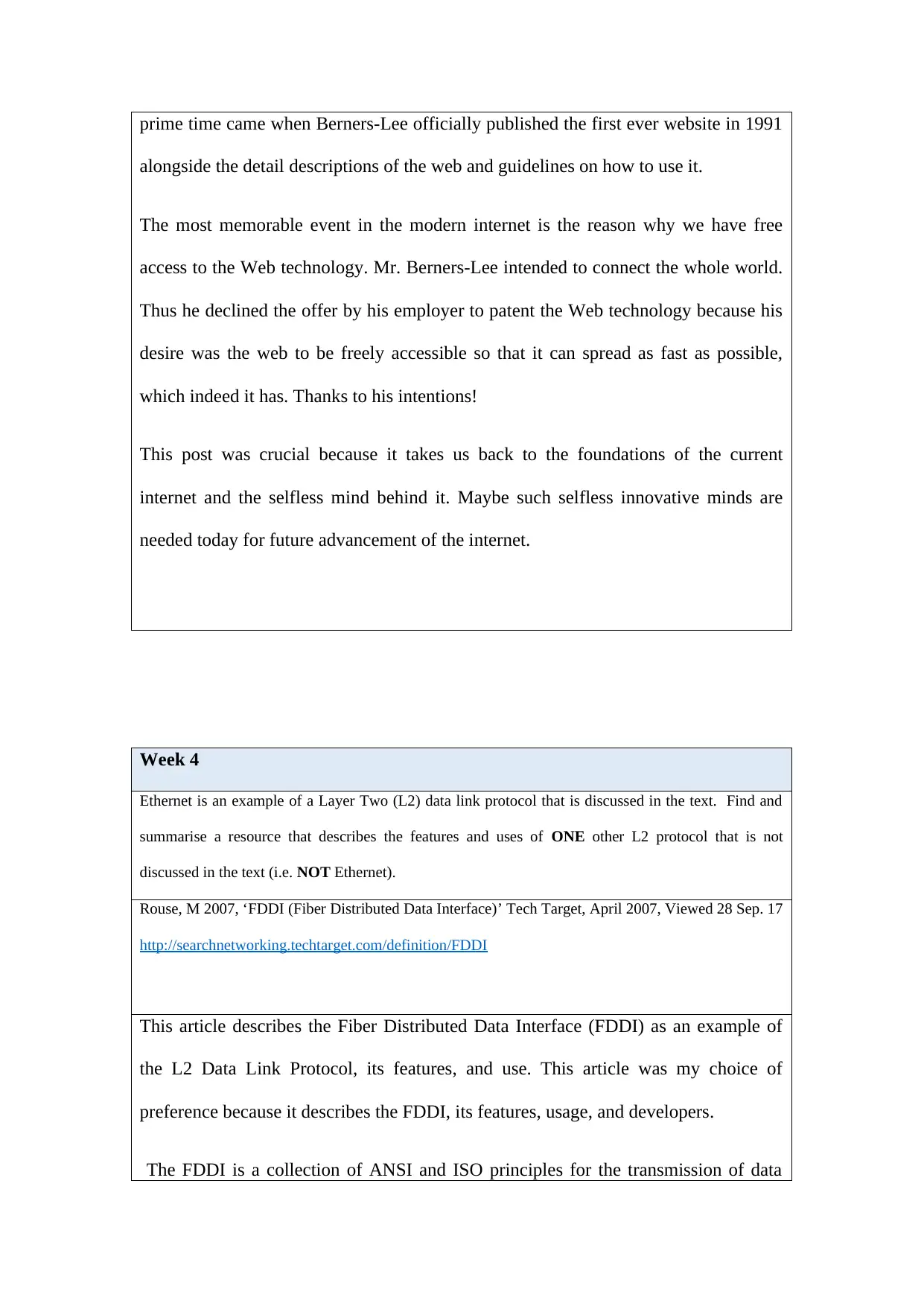
prime time came when Berners-Lee officially published the first ever website in 1991
alongside the detail descriptions of the web and guidelines on how to use it.
The most memorable event in the modern internet is the reason why we have free
access to the Web technology. Mr. Berners-Lee intended to connect the whole world.
Thus he declined the offer by his employer to patent the Web technology because his
desire was the web to be freely accessible so that it can spread as fast as possible,
which indeed it has. Thanks to his intentions!
This post was crucial because it takes us back to the foundations of the current
internet and the selfless mind behind it. Maybe such selfless innovative minds are
needed today for future advancement of the internet.
Week 4
Ethernet is an example of a Layer Two (L2) data link protocol that is discussed in the text. Find and
summarise a resource that describes the features and uses of ONE other L2 protocol that is not
discussed in the text (i.e. NOT Ethernet).
Rouse, M 2007, ‘FDDI (Fiber Distributed Data Interface)’ Tech Target, April 2007, Viewed 28 Sep. 17
http://searchnetworking.techtarget.com/definition/FDDI
This article describes the Fiber Distributed Data Interface (FDDI) as an example of
the L2 Data Link Protocol, its features, and use. This article was my choice of
preference because it describes the FDDI, its features, usage, and developers.
The FDDI is a collection of ANSI and ISO principles for the transmission of data
alongside the detail descriptions of the web and guidelines on how to use it.
The most memorable event in the modern internet is the reason why we have free
access to the Web technology. Mr. Berners-Lee intended to connect the whole world.
Thus he declined the offer by his employer to patent the Web technology because his
desire was the web to be freely accessible so that it can spread as fast as possible,
which indeed it has. Thanks to his intentions!
This post was crucial because it takes us back to the foundations of the current
internet and the selfless mind behind it. Maybe such selfless innovative minds are
needed today for future advancement of the internet.
Week 4
Ethernet is an example of a Layer Two (L2) data link protocol that is discussed in the text. Find and
summarise a resource that describes the features and uses of ONE other L2 protocol that is not
discussed in the text (i.e. NOT Ethernet).
Rouse, M 2007, ‘FDDI (Fiber Distributed Data Interface)’ Tech Target, April 2007, Viewed 28 Sep. 17
http://searchnetworking.techtarget.com/definition/FDDI
This article describes the Fiber Distributed Data Interface (FDDI) as an example of
the L2 Data Link Protocol, its features, and use. This article was my choice of
preference because it describes the FDDI, its features, usage, and developers.
The FDDI is a collection of ANSI and ISO principles for the transmission of data
Paraphrase This Document
Need a fresh take? Get an instant paraphrase of this document with our AI Paraphraser
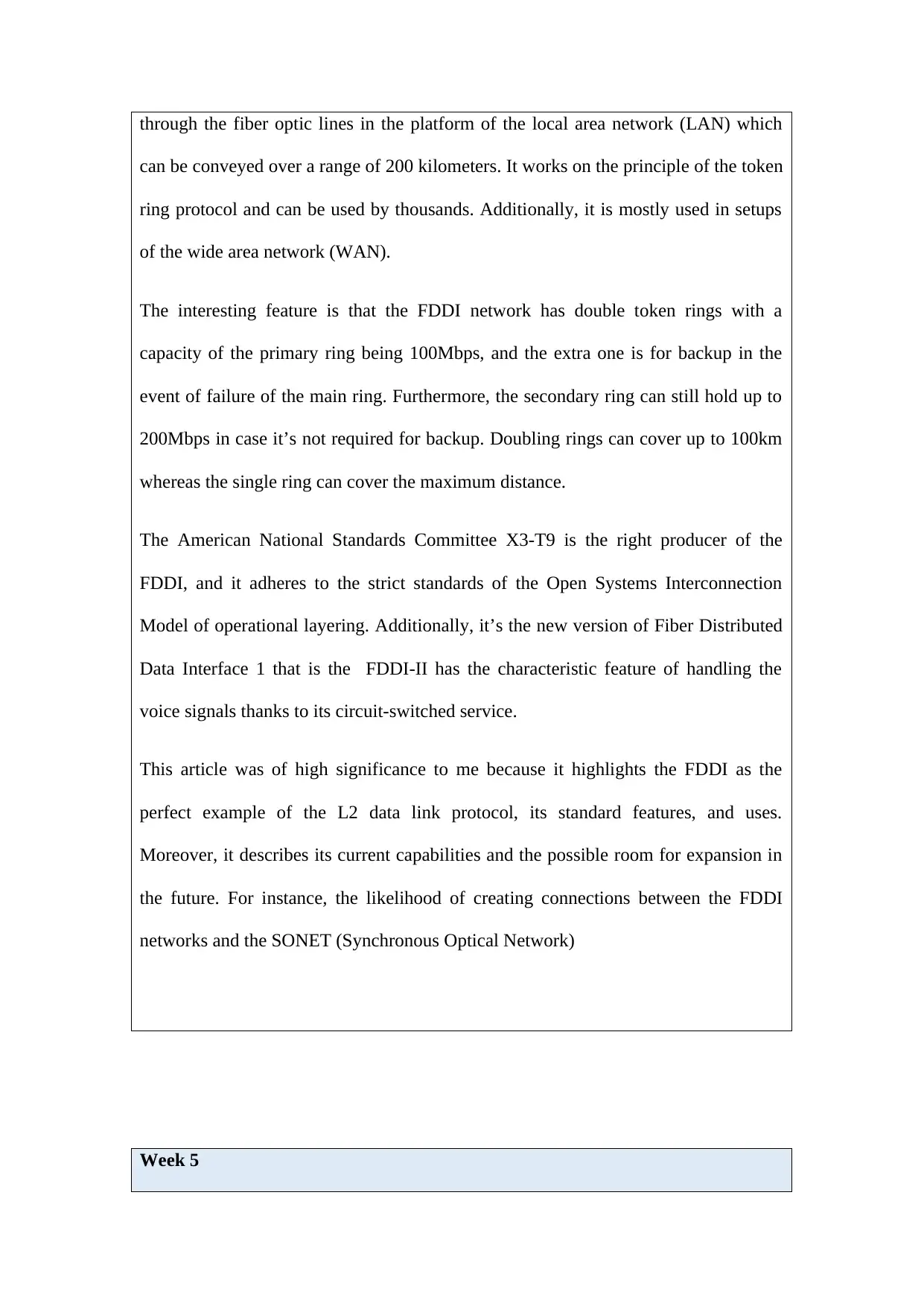
through the fiber optic lines in the platform of the local area network (LAN) which
can be conveyed over a range of 200 kilometers. It works on the principle of the token
ring protocol and can be used by thousands. Additionally, it is mostly used in setups
of the wide area network (WAN).
The interesting feature is that the FDDI network has double token rings with a
capacity of the primary ring being 100Mbps, and the extra one is for backup in the
event of failure of the main ring. Furthermore, the secondary ring can still hold up to
200Mbps in case it’s not required for backup. Doubling rings can cover up to 100km
whereas the single ring can cover the maximum distance.
The American National Standards Committee X3-T9 is the right producer of the
FDDI, and it adheres to the strict standards of the Open Systems Interconnection
Model of operational layering. Additionally, it’s the new version of Fiber Distributed
Data Interface 1 that is the FDDI-II has the characteristic feature of handling the
voice signals thanks to its circuit-switched service.
This article was of high significance to me because it highlights the FDDI as the
perfect example of the L2 data link protocol, its standard features, and uses.
Moreover, it describes its current capabilities and the possible room for expansion in
the future. For instance, the likelihood of creating connections between the FDDI
networks and the SONET (Synchronous Optical Network)
Week 5
can be conveyed over a range of 200 kilometers. It works on the principle of the token
ring protocol and can be used by thousands. Additionally, it is mostly used in setups
of the wide area network (WAN).
The interesting feature is that the FDDI network has double token rings with a
capacity of the primary ring being 100Mbps, and the extra one is for backup in the
event of failure of the main ring. Furthermore, the secondary ring can still hold up to
200Mbps in case it’s not required for backup. Doubling rings can cover up to 100km
whereas the single ring can cover the maximum distance.
The American National Standards Committee X3-T9 is the right producer of the
FDDI, and it adheres to the strict standards of the Open Systems Interconnection
Model of operational layering. Additionally, it’s the new version of Fiber Distributed
Data Interface 1 that is the FDDI-II has the characteristic feature of handling the
voice signals thanks to its circuit-switched service.
This article was of high significance to me because it highlights the FDDI as the
perfect example of the L2 data link protocol, its standard features, and uses.
Moreover, it describes its current capabilities and the possible room for expansion in
the future. For instance, the likelihood of creating connections between the FDDI
networks and the SONET (Synchronous Optical Network)
Week 5
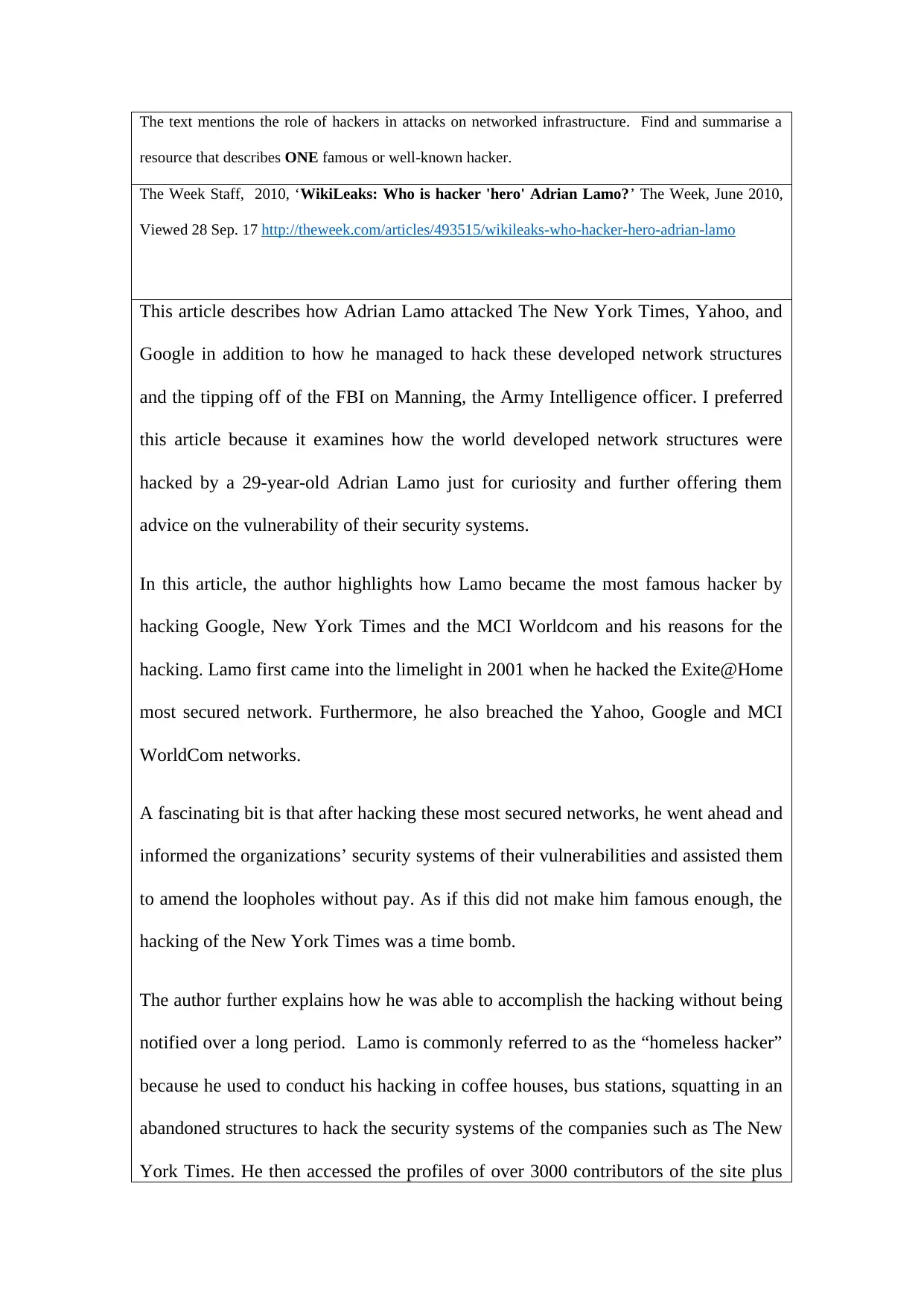
The text mentions the role of hackers in attacks on networked infrastructure. Find and summarise a
resource that describes ONE famous or well-known hacker.
The Week Staff, 2010, ‘WikiLeaks: Who is hacker 'hero' Adrian Lamo?’ The Week, June 2010,
Viewed 28 Sep. 17 http://theweek.com/articles/493515/wikileaks-who-hacker-hero-adrian-lamo
This article describes how Adrian Lamo attacked The New York Times, Yahoo, and
Google in addition to how he managed to hack these developed network structures
and the tipping off of the FBI on Manning, the Army Intelligence officer. I preferred
this article because it examines how the world developed network structures were
hacked by a 29-year-old Adrian Lamo just for curiosity and further offering them
advice on the vulnerability of their security systems.
In this article, the author highlights how Lamo became the most famous hacker by
hacking Google, New York Times and the MCI Worldcom and his reasons for the
hacking. Lamo first came into the limelight in 2001 when he hacked the Exite@Home
most secured network. Furthermore, he also breached the Yahoo, Google and MCI
WorldCom networks.
A fascinating bit is that after hacking these most secured networks, he went ahead and
informed the organizations’ security systems of their vulnerabilities and assisted them
to amend the loopholes without pay. As if this did not make him famous enough, the
hacking of the New York Times was a time bomb.
The author further explains how he was able to accomplish the hacking without being
notified over a long period. Lamo is commonly referred to as the “homeless hacker”
because he used to conduct his hacking in coffee houses, bus stations, squatting in an
abandoned structures to hack the security systems of the companies such as The New
York Times. He then accessed the profiles of over 3000 contributors of the site plus
resource that describes ONE famous or well-known hacker.
The Week Staff, 2010, ‘WikiLeaks: Who is hacker 'hero' Adrian Lamo?’ The Week, June 2010,
Viewed 28 Sep. 17 http://theweek.com/articles/493515/wikileaks-who-hacker-hero-adrian-lamo
This article describes how Adrian Lamo attacked The New York Times, Yahoo, and
Google in addition to how he managed to hack these developed network structures
and the tipping off of the FBI on Manning, the Army Intelligence officer. I preferred
this article because it examines how the world developed network structures were
hacked by a 29-year-old Adrian Lamo just for curiosity and further offering them
advice on the vulnerability of their security systems.
In this article, the author highlights how Lamo became the most famous hacker by
hacking Google, New York Times and the MCI Worldcom and his reasons for the
hacking. Lamo first came into the limelight in 2001 when he hacked the Exite@Home
most secured network. Furthermore, he also breached the Yahoo, Google and MCI
WorldCom networks.
A fascinating bit is that after hacking these most secured networks, he went ahead and
informed the organizations’ security systems of their vulnerabilities and assisted them
to amend the loopholes without pay. As if this did not make him famous enough, the
hacking of the New York Times was a time bomb.
The author further explains how he was able to accomplish the hacking without being
notified over a long period. Lamo is commonly referred to as the “homeless hacker”
because he used to conduct his hacking in coffee houses, bus stations, squatting in an
abandoned structures to hack the security systems of the companies such as The New
York Times. He then accessed the profiles of over 3000 contributors of the site plus
⊘ This is a preview!⊘
Do you want full access?
Subscribe today to unlock all pages.

Trusted by 1+ million students worldwide

the former president Jimmy Carter. He was charged with fraud and agreed with the
prosecutors and received twenty-four weeks of house arrest.
This article was useful because it described how Lamo attacked the networked
infrastructures and his reasons for hacking and how he was able to pass by the
security systems without being noticed.
prosecutors and received twenty-four weeks of house arrest.
This article was useful because it described how Lamo attacked the networked
infrastructures and his reasons for hacking and how he was able to pass by the
security systems without being noticed.
Paraphrase This Document
Need a fresh take? Get an instant paraphrase of this document with our AI Paraphraser
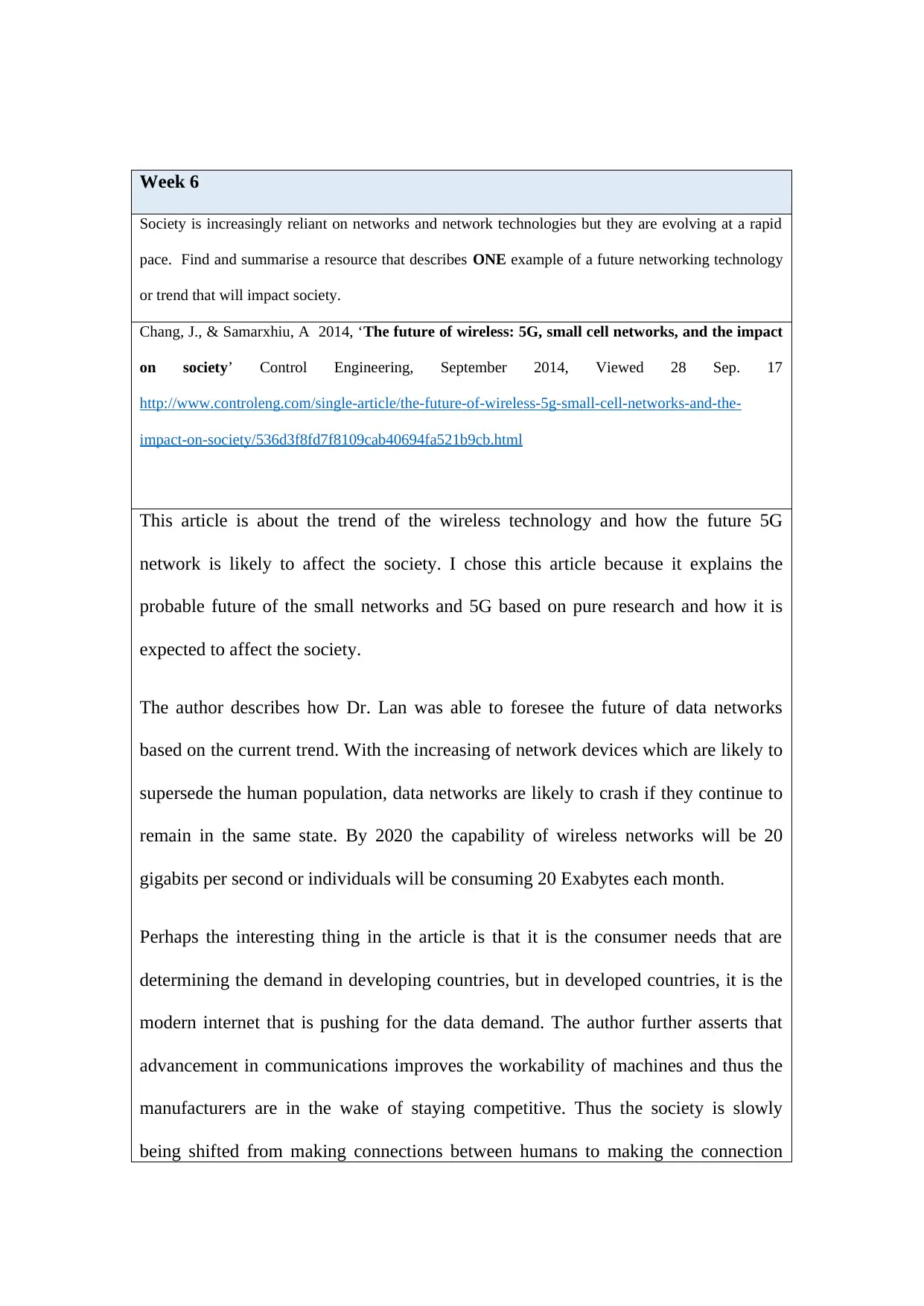
Week 6
Society is increasingly reliant on networks and network technologies but they are evolving at a rapid
pace. Find and summarise a resource that describes ONE example of a future networking technology
or trend that will impact society.
Chang, J., & Samarxhiu, A 2014, ‘The future of wireless: 5G, small cell networks, and the impact
on society’ Control Engineering, September 2014, Viewed 28 Sep. 17
http://www.controleng.com/single-article/the-future-of-wireless-5g-small-cell-networks-and-the-
impact-on-society/536d3f8fd7f8109cab40694fa521b9cb.html
This article is about the trend of the wireless technology and how the future 5G
network is likely to affect the society. I chose this article because it explains the
probable future of the small networks and 5G based on pure research and how it is
expected to affect the society.
The author describes how Dr. Lan was able to foresee the future of data networks
based on the current trend. With the increasing of network devices which are likely to
supersede the human population, data networks are likely to crash if they continue to
remain in the same state. By 2020 the capability of wireless networks will be 20
gigabits per second or individuals will be consuming 20 Exabytes each month.
Perhaps the interesting thing in the article is that it is the consumer needs that are
determining the demand in developing countries, but in developed countries, it is the
modern internet that is pushing for the data demand. The author further asserts that
advancement in communications improves the workability of machines and thus the
manufacturers are in the wake of staying competitive. Thus the society is slowly
being shifted from making connections between humans to making the connection
Society is increasingly reliant on networks and network technologies but they are evolving at a rapid
pace. Find and summarise a resource that describes ONE example of a future networking technology
or trend that will impact society.
Chang, J., & Samarxhiu, A 2014, ‘The future of wireless: 5G, small cell networks, and the impact
on society’ Control Engineering, September 2014, Viewed 28 Sep. 17
http://www.controleng.com/single-article/the-future-of-wireless-5g-small-cell-networks-and-the-
impact-on-society/536d3f8fd7f8109cab40694fa521b9cb.html
This article is about the trend of the wireless technology and how the future 5G
network is likely to affect the society. I chose this article because it explains the
probable future of the small networks and 5G based on pure research and how it is
expected to affect the society.
The author describes how Dr. Lan was able to foresee the future of data networks
based on the current trend. With the increasing of network devices which are likely to
supersede the human population, data networks are likely to crash if they continue to
remain in the same state. By 2020 the capability of wireless networks will be 20
gigabits per second or individuals will be consuming 20 Exabytes each month.
Perhaps the interesting thing in the article is that it is the consumer needs that are
determining the demand in developing countries, but in developed countries, it is the
modern internet that is pushing for the data demand. The author further asserts that
advancement in communications improves the workability of machines and thus the
manufacturers are in the wake of staying competitive. Thus the society is slowly
being shifted from making connections between humans to making the connection
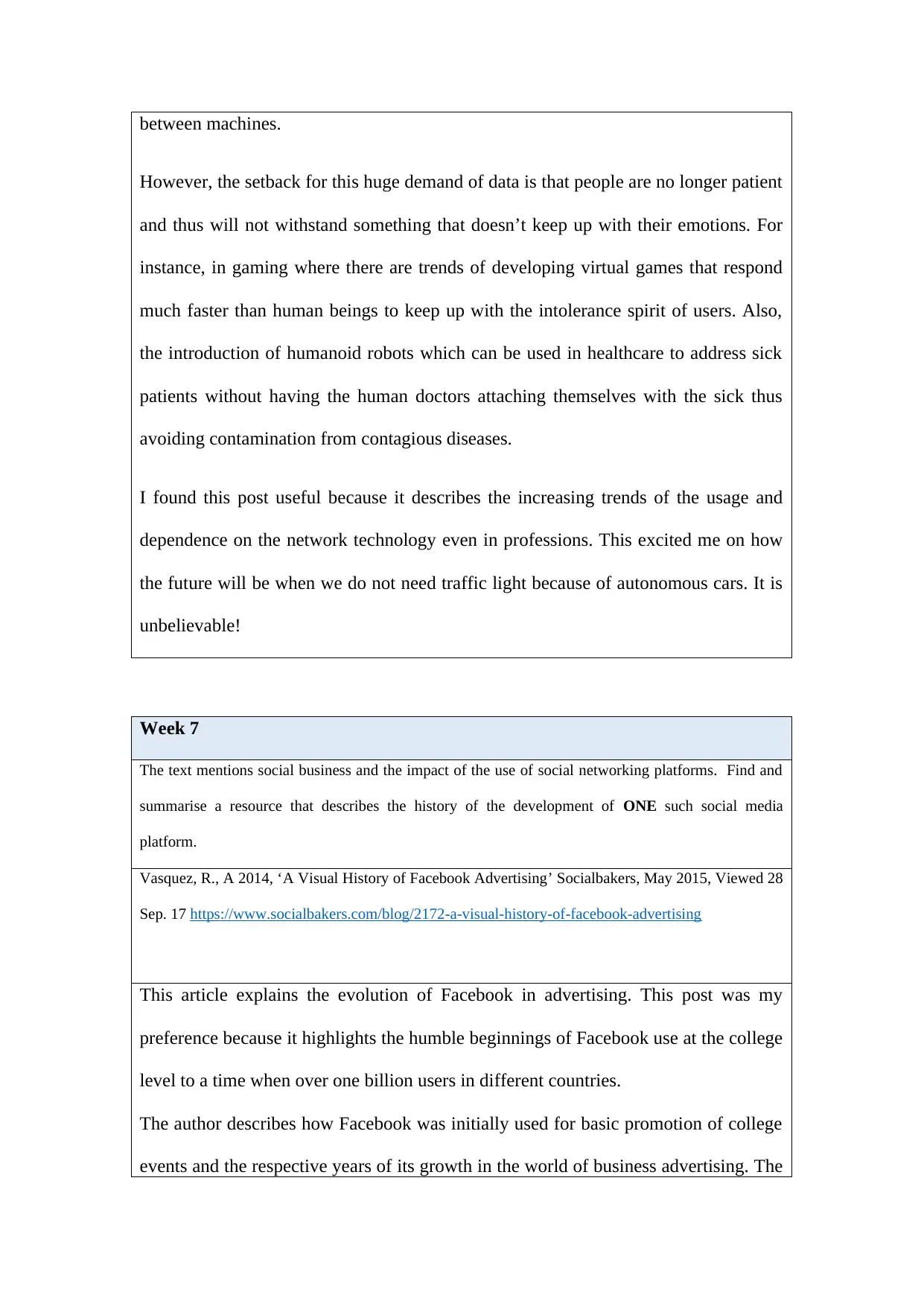
between machines.
However, the setback for this huge demand of data is that people are no longer patient
and thus will not withstand something that doesn’t keep up with their emotions. For
instance, in gaming where there are trends of developing virtual games that respond
much faster than human beings to keep up with the intolerance spirit of users. Also,
the introduction of humanoid robots which can be used in healthcare to address sick
patients without having the human doctors attaching themselves with the sick thus
avoiding contamination from contagious diseases.
I found this post useful because it describes the increasing trends of the usage and
dependence on the network technology even in professions. This excited me on how
the future will be when we do not need traffic light because of autonomous cars. It is
unbelievable!
Week 7
The text mentions social business and the impact of the use of social networking platforms. Find and
summarise a resource that describes the history of the development of ONE such social media
platform.
Vasquez, R., A 2014, ‘A Visual History of Facebook Advertising’ Socialbakers, May 2015, Viewed 28
Sep. 17 https://www.socialbakers.com/blog/2172-a-visual-history-of-facebook-advertising
This article explains the evolution of Facebook in advertising. This post was my
preference because it highlights the humble beginnings of Facebook use at the college
level to a time when over one billion users in different countries.
The author describes how Facebook was initially used for basic promotion of college
events and the respective years of its growth in the world of business advertising. The
However, the setback for this huge demand of data is that people are no longer patient
and thus will not withstand something that doesn’t keep up with their emotions. For
instance, in gaming where there are trends of developing virtual games that respond
much faster than human beings to keep up with the intolerance spirit of users. Also,
the introduction of humanoid robots which can be used in healthcare to address sick
patients without having the human doctors attaching themselves with the sick thus
avoiding contamination from contagious diseases.
I found this post useful because it describes the increasing trends of the usage and
dependence on the network technology even in professions. This excited me on how
the future will be when we do not need traffic light because of autonomous cars. It is
unbelievable!
Week 7
The text mentions social business and the impact of the use of social networking platforms. Find and
summarise a resource that describes the history of the development of ONE such social media
platform.
Vasquez, R., A 2014, ‘A Visual History of Facebook Advertising’ Socialbakers, May 2015, Viewed 28
Sep. 17 https://www.socialbakers.com/blog/2172-a-visual-history-of-facebook-advertising
This article explains the evolution of Facebook in advertising. This post was my
preference because it highlights the humble beginnings of Facebook use at the college
level to a time when over one billion users in different countries.
The author describes how Facebook was initially used for basic promotion of college
events and the respective years of its growth in the world of business advertising. The
⊘ This is a preview!⊘
Do you want full access?
Subscribe today to unlock all pages.

Trusted by 1+ million students worldwide
1 out of 21
Related Documents
Your All-in-One AI-Powered Toolkit for Academic Success.
+13062052269
info@desklib.com
Available 24*7 on WhatsApp / Email
![[object Object]](/_next/static/media/star-bottom.7253800d.svg)
Unlock your academic potential
Copyright © 2020–2025 A2Z Services. All Rights Reserved. Developed and managed by ZUCOL.





